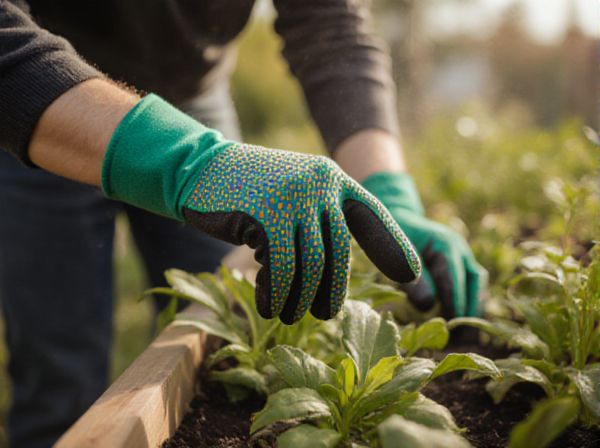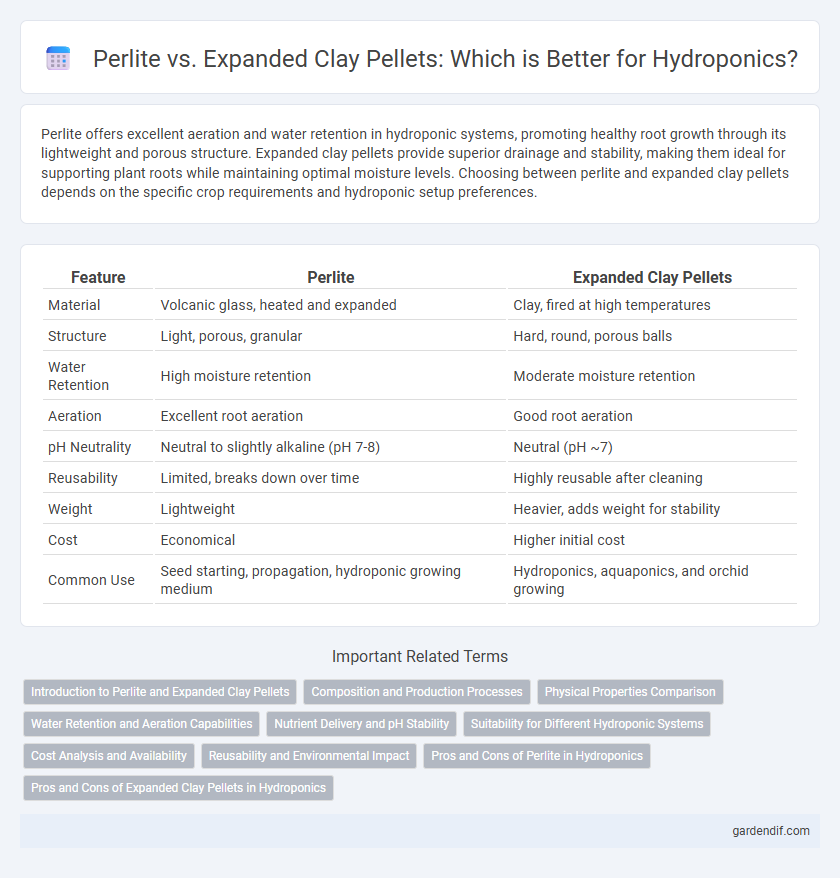
Perlite vs Expanded Clay Pellets Illustration
Perlite offers excellent aeration and water retention in hydroponic systems, promoting healthy root growth through its lightweight and porous structure. Expanded clay pellets provide superior drainage and stability, making them ideal for supporting plant roots while maintaining optimal moisture levels. Choosing between perlite and expanded clay pellets depends on the specific crop requirements and hydroponic setup preferences.
Table of Comparison
| Feature | Perlite | Expanded Clay Pellets |
|---|---|---|
| Material | Volcanic glass, heated and expanded | Clay, fired at high temperatures |
| Structure | Light, porous, granular | Hard, round, porous balls |
| Water Retention | High moisture retention | Moderate moisture retention |
| Aeration | Excellent root aeration | Good root aeration |
| pH Neutrality | Neutral to slightly alkaline (pH 7-8) | Neutral (pH ~7) |
| Reusability | Limited, breaks down over time | Highly reusable after cleaning |
| Weight | Lightweight | Heavier, adds weight for stability |
| Cost | Economical | Higher initial cost |
| Common Use | Seed starting, propagation, hydroponic growing medium | Hydroponics, aquaponics, and orchid growing |
Introduction to Perlite and Expanded Clay Pellets
Perlite is a volcanic glass that expands when heated, creating a lightweight, porous medium ideal for aeration and moisture retention in hydroponic systems. Expanded clay pellets, also known as hydroton, are lightweight, porous clay balls that promote excellent drainage and airflow, supporting robust root development. Both media provide stable pH and chemical inertness, critical for maintaining nutrient balance in hydroponic growing environments.
Composition and Production Processes
Perlite is a volcanic glass that expands when heated to high temperatures, creating lightweight, porous granules ideal for aeration and moisture retention in hydroponic systems. Expanded clay pellets are produced by heating natural clay at high temperatures until it softens and expands into round, porous balls that provide excellent drainage and structural support. Both substrates offer distinct advantages: perlite's mineral-based composition promotes oxygenation, while expanded clay pellets' durable structure enhances reusable system lifespan.
Physical Properties Comparison
Perlite offers excellent aeration and drainage due to its lightweight, porous structure with a particle density of approximately 110-130 kg/m3, while expanded clay pellets provide superior water retention and structural stability with a density around 320-560 kg/m3. Expanded clay pellets maintain consistent porosity and resist compaction over time, supporting long-term root oxygenation, whereas perlite tends to break down under mechanical stress and can float during irrigation. The choice between perlite and expanded clay pellets depends on specific hydroponic system requirements for moisture retention, root support, and airflow.
Water Retention and Aeration Capabilities
Expanded clay pellets offer superior aeration due to their porous structure, promoting healthy root oxygenation, while perlite excels in water retention with its lightweight, porous texture that holds moisture effectively. Perlite's high water retention capacity minimizes the risk of plant dehydration in hydroponic systems. Conversely, expanded clay's balance of moderate water retention and excellent aeration reduces root rot and supports faster plant growth.
Nutrient Delivery and pH Stability
Perlite offers excellent aeration and drainage but has limited nutrient retention, requiring more frequent nutrient solution adjustments in hydroponic systems. Expanded clay pellets provide superior nutrient delivery by holding moisture and nutrients around the root zone, promoting consistent availability. Both media are pH-neutral, but expanded clay's durability ensures stable pH conditions over longer periods, reducing fluctuations that can affect plant growth.
Suitability for Different Hydroponic Systems
Perlite offers excellent aeration and drainage, making it ideal for wick and drip hydroponic systems that require consistent moisture control. Expanded clay pellets provide superior stability and water retention, which suits ebb and flow and deep water culture systems where root support and oxygen availability are crucial. Choosing between the two depends on the specific system's water retention needs, aeration preferences, and root structure support.
Cost Analysis and Availability
Perlite offers a cost-effective growing medium with widespread availability and low purchase price, making it ideal for budget-conscious hydroponic systems. Expanded clay pellets typically incur higher costs due to their manufacturing process, yet their durability allows for reuse, potentially offsetting initial expenses over time. Availability varies regionally, with perlite being more globally accessible, while expanded clay pellets may require sourcing from specialized suppliers.
Reusability and Environmental Impact
Expanded clay pellets offer superior reusability compared to perlite, as they can be thoroughly cleaned and sterilized without breaking down, reducing the need for frequent replacement in hydroponic systems. In contrast, perlite tends to degrade and become compacted over time, limiting its effective lifespan and increasing waste generation. Environmentally, expanded clay pellets have a lower ecological footprint due to their durability and potential for multiple reuse cycles, whereas perlite's single-use nature leads to more frequent disposal and resource consumption.
Pros and Cons of Perlite in Hydroponics
Perlite enhances hydroponic systems by improving aeration and drainage, reducing root rot risks, and providing a lightweight, pH-neutral growing medium. However, its fine particles can cause dust issues during handling, and it tends to dry out quickly, requiring frequent watering. Compared to expanded clay pellets, perlite may break down faster and offer less structural stability for larger plants.
Pros and Cons of Expanded Clay Pellets in Hydroponics
Expanded clay pellets offer excellent aeration and drainage for hydroponic systems, promoting robust root growth and preventing waterlogging. Their lightweight, reusable nature enhances sustainability, but they can retain salts, requiring regular flushing to prevent nutrient buildup. Compared to perlite, expanded clay provides superior pH neutrality and physical stability, making it a preferred medium for long-term hydroponic cultivation.
Perlite vs Expanded Clay Pellets Infographic

 gardendif.com
gardendif.com